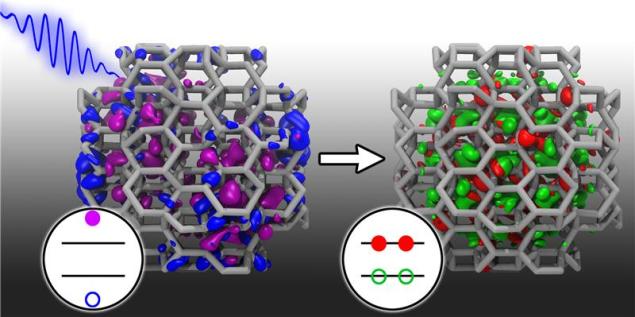Jan 30 2013
Using an exotic form of silicon could substantially improve the efficiency of solar cells, according to computer simulations by researchers at the University of California, Davis, and in Hungary. The work was published Jan. 25 in the journal Physical Review Letters.
 Computer simulations show that when a light particle (blue wave on left) hits a crystal of a high-pressure form of silicon, it releases two electron-hole pairs (red circles/green rings), which generate electric current. Credit: Stefan Wippermann/UC Davis.
Computer simulations show that when a light particle (blue wave on left) hits a crystal of a high-pressure form of silicon, it releases two electron-hole pairs (red circles/green rings), which generate electric current. Credit: Stefan Wippermann/UC Davis.
Solar cells are based on the photoelectric effect: a photon, or particle of light, hits a silicon crystal and generates a negatively charged electron and a positively charged hole. Collecting those electron-hole pairs generates electric current.
Conventional solar cells generate one electron-hole pair per incoming photon, and have a theoretical maximum efficiency of 33 percent. One exciting new route to improved efficiency is to generate more than one electron-hole pair per photon, said Giulia Galli, professor of chemistry at UC Davis and co-author of the paper.
"This approach is capable of increasing the maximum efficiency to 42 percent, beyond any solar cell available today, which would be a pretty big deal," said lead author Stefan Wippermann, a postdoctoral researcher at UC Davis.
"In fact, there is reason to believe that if parabolic mirrors are used to focus the sunlight on such a new-paradigm solar cell, its efficiency could reach as high as 70 percent," Wippermann said.
Galli said that nanoparticles have a size of nanometers, typically just a few atoms across. Because of their small size, many of their properties are different from bulk materials. In particular, the probability of generating more than one electron-hole pair is much enhanced, driven by an effect called "quantum confinement." Experiments to explore this paradigm are being pursued by researchers at the Los Alamos National Laboratory, the National Renewable Energy Laboratory in Golden, Colo., as well as at UC Davis.
"But with nanoparticles of conventional silicon, the paradigm works only in ultraviolet light," Wippermann said. "This new approach will become useful only when it is demonstrated to work in visible sunlight."
The researchers simulated the behavior of a structure of silicon called silicon BC8, which is formed under high pressure but is stable at normal pressures, much as diamond is a form of carbon formed under high pressure but stable at normal pressures.
The computer simulations were run through the National Energy Research Scientific Supercomputing Center at the Lawrence Berkeley Laboratory, which granted the project 10 million hours of supercomputer time.
The simulations demonstrated that nanoparticles of silicon BC8 indeed generate multiple electron-hole pairs per photon even when exposed to visible light.
"This is more than an academic exercise. A Harvard-MIT paper showed that when normal silicon solar cells are irradiated with laser light, the energy the laser emits may create a local pressure high enough to form BC8 nanocrystals. Thus, laser or chemical pressure treatment of existing solar cells may turn them into these higher-efficiency cells," said co-author Gergely Zimanyi, professor of physics at UC Davis.
Other authors of the paper are Marton Voros and Adam Gali at the Budapest University of Technology and Economics, Hungary.
The work was funded by a National Science Foundation Solar Collaborative grant awarded to Zimanyi, Galli and colleagues at UC Davis and UC Santa Cruz in 2011. The project brings together experts in material science, chemistry, computer simulations and statistics to develop new approaches to solar power.